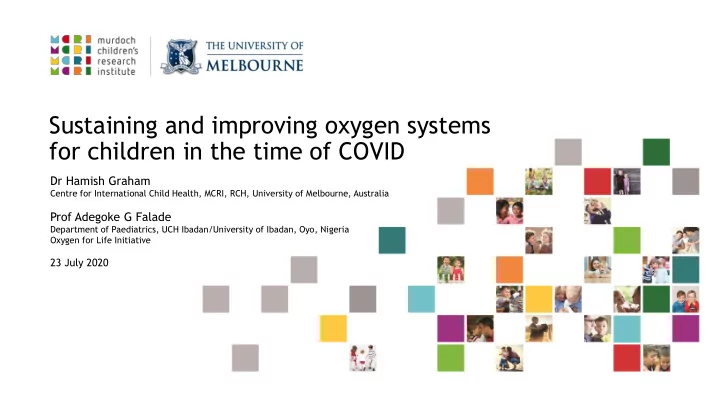

Sustaining and improving oxygen systems for children in the time of COVID Dr Hamish Graham Centre for International Child Health, MCRI, RCH, University of Melbourne, Australia Prof Adegoke G Falade Department of Paediatrics, UCH Ibadan/University of Ibadan, Oyo, Nigeria Oxygen for Life Initiative 23 July 2020 @ Murdoch Children ’ s Research Institute, 2017
Acknowledgments Prof A.G. Falade, Dr Bakare, and the Oxygen for Life team. Partners – WHO, UNICEF , CHAI, PATH, Save the Children, Hewatele, ASSIST , many others
3
Patient-centred approach to oxygen access Do you have oxygen equipment? 90% (cylinders, concentrators) Is it available and working in child and newborn areas? 50% Are staff trained & equipped appropriately? 20% <20% Do patients get oxygen when they need it? (right time, right way, right duration, right cost) Bakare, A. A., et al. (2020). "Providing oxygen to children and newborns: a multi-faceted technical and clinical assessment of oxygen access and oxygen 6 use in secondary-level hospitals in southwest Nigeria." International health.
Opportunities to “build back better” 7
Opportunities to “ build back better ” 1. Prompt and accurate identification of patients who need oxygen (specifically, hypoxaemia ) 2. Reliable, continuous supply of medical-grade oxygen 3. Healthcare workers with the skills, equipment and motivation to use oxygen well 4. Technicians with the skills, equipment and motivation to maintain oxygen equipment well 5. Holistic approach to hospital oxygen systems 8
#1 - Pulse oximetry, pulse oximetry, pulse oximetry! Hypoxaemia is… Common! 22% of sick neonates >30% neonatal encephalopathy >25% preterm/small 15% of sick infants >35% pneumonia Graham, H. R., et al. (2019). "Hypoxaemia in hospitalised children and neonates: a prospective cohort study in Nigerian secondary-level hospitals." 9 EClinicalMedicine.
#1 - Pulse oximetry, pulse oximetry, pulse oximetry! Hypoxaemia is … Common! 22% of sick neonates >30% neonatal encephalopathy >25% preterm/small 15% of sick infants >35% pneumonia Deadly! Increases risk of death 7-fold Increasing risk with low SpO 2 Difficult to detect clinically Graham, H. R., et al. (2019). "Hypoxaemia in hospitalised children and neonates: a prospective cohort study in Nigerian secondary-level hospitals." 10 EClinicalMedicine.
#1 - Pulse oximetry, pulse oximetry, pulse oximetry! Graham, H. R., et al. (2018). "Adoption of paediatric and neonatal pulse oximetry by 12 hospitals in Nigeria: a mixed-methods realist evaluation." BMJ 11 Glob Health 3: e000812.
#2 – Reliable oxygen supply What is medical grade oxygen? • >82% • Cylinders: typically 90-95% purity, (regulator) pressure 50psi Concentrators: typically 90-95% purity, outlet pressure <20psi • WHO and UNICEF (2019). WHO-UNICEF Technical Specifications and Guidance for Oxygen Therapy Devices. Geneva, WHO. 12 WHO (2015). Technical Specifications for Oxygen Concentrators. WHO Medical Device Technical Series. W. H. Organization. Geneva, WHO.
#2 – Reliable oxygen supply Cylinders Smaller facilities, Backup *stock out, refill, transport $$$ Concentrators Plants Medium facilities Large facilities COST EFFICIENCY *electricity *electricity +++ *piping or cylinder relay Liquid *technician/BME Large facilities *high pressure piping *BME $ COMPLEXITY complex simple 13
#3 - Clinical capacity Oxygen safety Too little (hypoxaemia) >90% • Too much (oxidative stress) Retinopathy of prematurity (ROP), BPD • • Preterm/small neonates 88-94% (or similar) Too variable Scott Haldane: “ like bringing a drowning man up to breathe then pushing him • under again ” WHO (2013). Pocket Book of Hospital care for children: guidelines for the management of common childhood illnesses. Geneva, WHO. 15 WHO (2016). Oxygen therapy for children. Geneva, WHO.
#3 - Clinical capacity Pulse oximetry !!! • Clinical guideline • Editable WHO-based templates here: https://bit.ly/O2clinical Age-appropriate delivery equipment Nasal prongs or catheter • • Humidifier only if higher flow rates (>2-4LPM) +/- air/oxygen mixer High-flow or CPAP – use air (21% oxygen), or mixer. • WHO (2013). Pocket Book of Hospital care for children: guidelines for the management of common childhood illnesses. Geneva, WHO. 16 WHO (2016). Oxygen therapy for children. Geneva, World Health Organization.
#4 – Involve technicians Most important people for providing oxygen safely to patients? (my opinion) 1. Nurses 2. Technicians 3. Doctors Technician resources • https://bit.ly/O2install 17
#5 - Oxygen systems Graham, H., et al. (2017). "Providing oxygen to children in hospitals: a realist review." Bulletin of the World Health Organization 95(4): 288-302. 18
#5 - Oxygen systems Planning Monitoring & Financing & feedback Procurement Maintenance schedules & Installation tools Technician Healthcare training & worker training support & support 20
View from the ground - Nigeria Nigeria Policies & Strategies • • National Strategy for the scale up of medical oxygen in health facilities (2017) • National Policy on medical oxygen in health facilities (2017) • National Integrated Pneumonia Control Strategy and Implementation Plan (2020) Financing • Responsible people/institutions • • Implementing partners Graham, H., et al. (2020). "Oxygen therapy for children: A key tool in reducing deaths from pneumonia." Pediatric Pulmonology 55(S1): S61-S64. 21
Summary 1. Patient-centred thinking . When we think about oxygen access, keep the patient at the centre. 2. Pulse oximetry is essential . If you are not already doing pulse oximetry routinely on all sick newborns and children, start doing it! 3. Get to know your equipment . Choose quality. Use it to its full capacity. Cost it over full life cycle. 4. Encourage responsible oxygen use. Right amount, right method, right patient, right duration. 5. Involve technicians in everything . 6. Think of the whole system . “ Do oxygen well, do infection control well, protect staff ” 22
Resources Oxygen collection (curated by UNICEF) https://bit.ly/O2resources • Clinical protocols and training: https://bit.ly/O2clinical • Cleaning equipment: https://bit.ly/O2clean • Technician resources: https://bit.ly/O2technicians Procurement and installation guide: https://bit.ly/O2install • WHO technical specifications • • WHO clinical guidelines – oxygen, children, COVID-19 • WHO oxygen planning documents and interim guidance Other resources • WHO medical devices: https://www.who.int/medical_devices/priority/COVID-19_medequipment/en/ Every Breath Counts: https://stoppneumonia.org/latest/covid-19/ • ASSIST International - oxygen series: https://assistinternational.org/covid19resources/ • • USAID Do No Harm – oxygen brief: https://www.everypreemie.org/donoharmbriefs/ 23
Thank you Hamish.Graham@rch.org.au
Recommend
More recommend